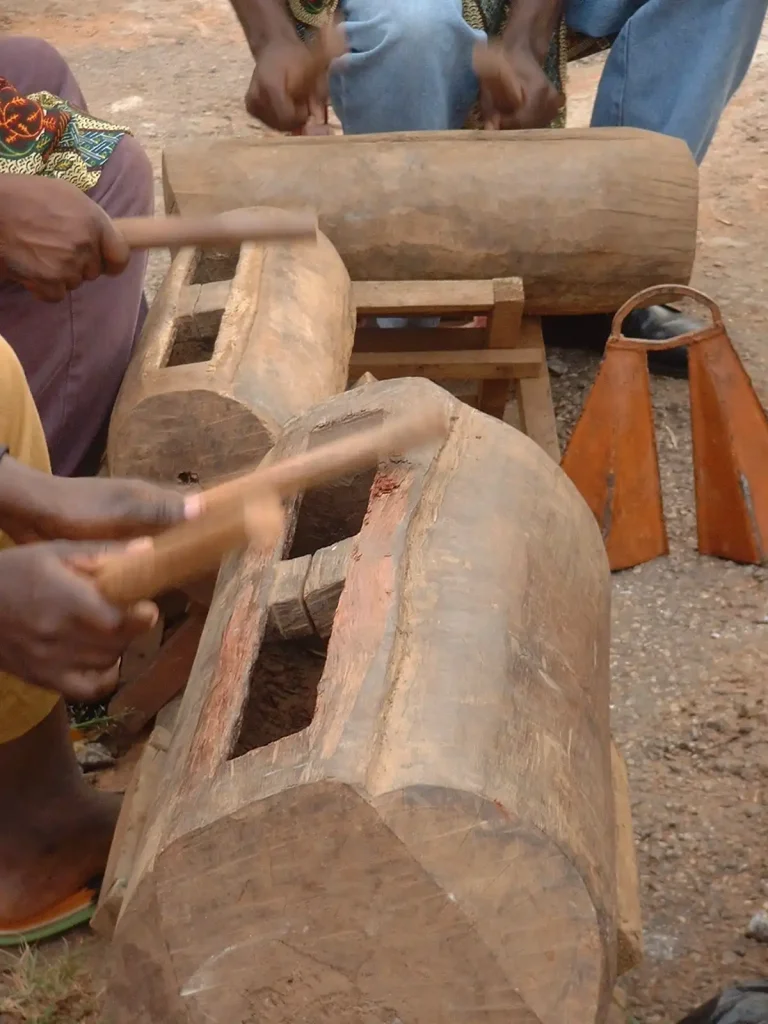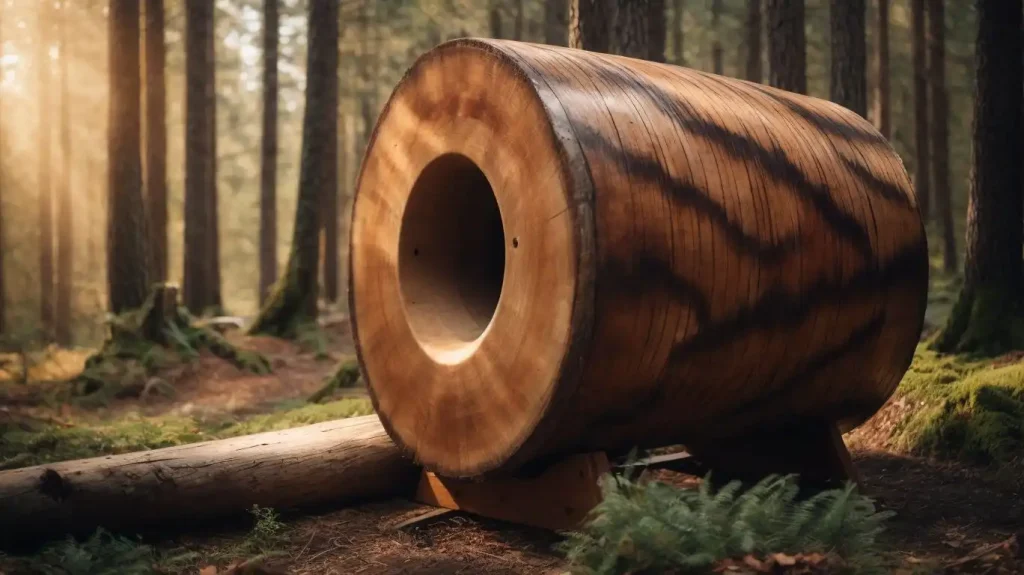Have you ever heard of a musical instrument called the Slit Gong? It’s not like most drums you might know. Instead of having a skin or fabric stretched over the top, the slit gong is a hollow log with a long slit carved into it, creating a unique look and sound. Let’s dive into the world of this amazing instrument to learn how it works, where it comes from, and why it’s so special!

What is a Slit Gong?
A slit gong, also known as a slit drum, is a type of drum made from a hollowed-out tree trunk or thick piece of wood. The main feature of a slit gong is, of course, the long slit cut across the top. When someone strikes the drum with a mallet or stick, the wood vibrates and produces sound. The size and depth of the slit influence the pitch and tone of the drum, which is why no two slit gongs sound exactly the same!

Unlike regular drums with skins stretched across them, the slit gong doesn’t use any material over the opening. Instead, it relies on the natural resonance of the wood itself. This makes the sound of a slit gong very unique. When struck, it can create deep, booming sounds that can carry over long distances.

History and Cultural Significance of the Slit Gong
The slit gong has been around for centuries and can be found in various cultures across the world, particularly in Africa, Southeast Asia, and the Pacific Islands. In places like New Guinea, the Solomon Islands, and Vanuatu, slit gongs are not just musical instruments—they’re deeply important symbols in the culture.

In many of these communities, slit gongs were traditionally used to send messages across villages or even between distant settlements. Because their sound travels so far, people used the slit gong to announce important events, warn others of danger, or call the community together for gatherings. Imagine a drum being used like a loudspeaker in ancient times!

Some of the largest slit gongs ever discovered are from Vanuatu, a group of islands in the Pacific Ocean. These giant gongs, carved out of enormous tree trunks, can reach up to three metres in height and are often ornately decorated with carvings and symbols representing the community’s heritage and beliefs. This shows just how important these instruments are in these societies—not just as tools, but as artworks and cultural treasures.

How is a Slit Gong Made?
Making a slit gong is no easy task! In many traditional cultures, creating one requires great skill and craftsmanship. Here’s a look at the typical process:
- Selecting the Tree: A large, solid tree trunk is chosen. This is often a tree that is known for its resonant wood, such as hardwood species that can produce a clear, deep sound.

- Hollowing the Log: Craftspeople then hollow out the inside of the tree trunk. This process can take days or even weeks, depending on the size of the slit gong.

- Carving the Slit: A long slit is carved along the top of the drum, creating two “tongues” of wood on either side. The thickness of each tongue can vary to create different tones when struck.

- Adding Decorations: Once the drum is complete, it is often decorated with intricate carvings. In some cultures, these carvings represent ancestors, spiritual symbols, or elements of the natural world.

- Tuning the Slit Gong: By carefully adjusting the depth and shape of the slit, makers can “tune” the drum to produce specific sounds. This tuning process is crucial, as it determines the final sound of the gong.

Playing the Slit Gong
Playing a slit gong is a rhythmic and expressive art. Musicians use wooden sticks or mallets to strike the “tongues” of the drum, creating a beat that can range from soft and gentle to loud and intense. In many cultures, people play the slit gong for ceremonies, celebrations, or even to accompany dances.

In some parts of the Pacific Islands, such as Vanuatu, slit gongs are played by groups of people in a rhythmic style, each drum producing different tones to form a complete rhythm. This is especially common during important cultural festivals or gatherings.

Slit Gong in Modern Times
Today, slit gongs are still used in traditional music and ceremonies, but they’ve also found a place in modern music and art. Artists and musicians have brought slit gongs to concert stages, museums, and art galleries worldwide. For example, some slit gongs are displayed in famous museums like the Metropolitan Museum of Art in New York and the Virginia Museum of Fine Arts, showing how this ancient instrument is valued as a piece of world heritage.

Even though we have all sorts of advanced technology and instruments today, the slit gong remains a fascinating link to ancient cultures and a reminder of how people around the world have created unique ways to communicate, celebrate, and express themselves.
Fun Facts About Slit Gongs
- Messaging Drums: Slit gongs were once used like a telephone or megaphone. Certain beats or rhythms could carry specific meanings, which other villages could understand!
- Hidden Meanings: In some cultures, only certain people knew how to “read” the messages of the slit gong. These people would be responsible for interpreting and responding to these drum messages.
- Huge Instruments: The biggest slit gongs, like those from Vanuatu, are taller than most people and require two or more players to play different sections at once.
- Artistic Carvings: Many slit gongs feature carvings of faces, animals, or abstract patterns. These decorations represent important cultural symbols or tell stories of ancestors.
Where to See and Hear a Slit Gong Today
If you’re curious about seeing or hearing a slit gong in person, you might find them in museums, especially those that focus on ethnomusicology or world cultures. Some museums have recordings you can listen to, giving you a sense of how these instruments sound when played. For example:
- Metropolitan Museum of Art (New York, USA): This museum has a collection of slit gongs that showcases the beauty and craftsmanship of these ancient instruments.

- Virginia Museum of Fine Arts (USA): Their online collection lets you see slit gongs from Oceania, where they originated.

And if you can’t make it to a museum, there are recordings and videos online where you can watch musicians play the slit gong, giving you a sense of its deep and resonant sounds.
Why the Slit Gong is So Special
The slit gong isn’t just an instrument; it’s a piece of history. It tells us how people in the past communicated, created art, and brought communities together. Each time a slit gong is played, it’s like hearing a piece of ancient wisdom passed down through the generations. Even as we invent new ways to make music, instruments like the slit gong remind us of the creativity and craftsmanship that humans have always shared.

So next time you hear a drum or see a musical performance, think about the slit gong and how music has helped people across the world connect, celebrate, and communicate—even from afar!
For more interesting articles, please visit www.kidzherald.com





